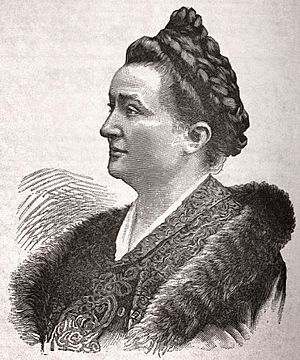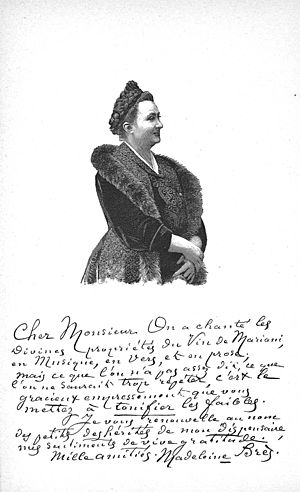Madeleine Brès facts for kids
Quick facts for kids
Madeleine Brès
|
|
|---|---|
 |
|
| Born |
Madeleine Gebelin
25 November 1842 Bouillargues, France
|
| Died | 30 November 1921 (aged 79) |
Madeleine Alexandrine Brès (born on November 26, 1842, in Bouillargues – died November 30, 1921, in Montrouge) was a very important French woman. She was the first French woman to earn a medical degree. She achieved this in 1875 after presenting her special research paper. Her work focused on breastfeeding and caring for children.
Contents
Early Life and Dreams
Madeleine Alexandrine Gebelin was born with a strong interest in medicine. She shared in a medical newspaper in 1895 that her passion began when she was very young. She often went with her father, who was a craftsman, when he worked at the hospital in Nîmes.
At the hospital, a kind nun took a liking to Madeleine. The nun taught her simple medical tasks. These included making herbal teas and special healing pastes.
When Madeleine was twelve, her family moved to Paris. A little after her fifteenth birthday, she married Adrien-Stéphane Brès, who worked on trams. Madeleine was able to go to college because of the efforts of Julie-Victoire Daubié. Julie-Victoire was the first woman in France to pass the baccalaureate exam in 1861. However, Madeleine first needed her husband's permission to study. This was because, at that time, French law said married women were legally controlled by their husbands.
Becoming a Doctor
In 1866, Madeleine went to see the head of the Medical School at the University of Paris, Charles Adolphe Wurtz. She asked him if she could study medicine. The dean agreed, but only if she first earned degrees in Arts and Sciences. Madeleine worked hard and completed this task in three years. By then, she was 26 years old and a mother of three children.
Madeleine went back to the dean and told him she had met all the requirements. She also pointed out that three women from other countries were already studying medicine in France. These women were Mary Putnam Jacobi from America, Catherine Gontcharoff from Russia, and Elizabeth Garrett Anderson from England.
Dean Würtz took Madeleine's request to the Minister of Education, Victor Duruy. The minister approved her admission. Even the Empress Eugénie helped support her application. Madeleine's husband formally gave his consent to the mayor in Paris. So, in 1869, she became a medical student. She began her studies at Pitié-Salpêtrière Hospital with Professor Broca. Her admission was also helped by a new law that allowed women to work.
During her studies, the Franco-Prussian War started. Many male doctors left the hospital to fight in the war. Because of this, Madeleine was asked to work as a temporary intern until July 1871. This experience made her want to work in hospitals even more. She tried to get a permanent hospital job. Even with Professor Broca's support, the hospital director refused her application in December 1871. He said it was not about her personally, but about setting a new rule for women in general.
Madeleine Brès decided not to push for a hospital job anymore. She was a widow with three children to support. She chose to become a pediatrician, a doctor who specializes in children. She wrote her important research paper, called Of Breasts and Breastfeeding. This paper covered many topics about mothers, babies, and keeping infants healthy. She defended her paper on June 3, 1875. She received high honors for her work. This made her the first French woman to become a Doctor of Medicine. However, she was not the very first woman to get a medical degree in France. Elizabeth Garrett Anderson had done so five years before her.
A Career Helping Children
While studying medicine, Madeleine also spent time at the National Museum of Natural History, France. She also worked in Professor Charles Adolphe Wurtz's lab. There, she prepared her research paper, which she presented on June 3, 1875. Her paper, "From the Bottle and breastfeeding", showed how the chemical makeup of breast milk changes. This change helps babies grow and develop better.
Her paper was highly praised and became famous in France and other countries. She then became the first French female doctor.
As a widow, Madeleine had three children to care for. She moved to Rue Boissy-d'Anglas in Paris. She decided to focus on the health of mothers and babies. She also specialized in keeping young infants healthy. Many wealthy families became her patients.
The city of Paris asked her to teach about health guidelines. She gave talks to staff at schools for mothers, crèches (daycares), and kindergartens across Paris.
In 1885, she opened her own nursery at 83 rue Nollet. Here, she cared for infants and young children up to age 3 for free. She paid for this nursery herself. Important people like Théophile Roussel and Marie-Louise Loubet visited her nursery. This nursery later became a city-run nursery. But it kept her name because of her important work for mothers and children.
Later, in 1891, she traveled to Switzerland. This was part of a project for the Ministry of Interior. She went to study how nurseries and hospitals were organized there.
Madeleine Brès also led a journal called "Women's and Children's Hygiene." She wrote many books about child care and nursing for children.
Later Life and Legacy
Before she passed away, a medical journal reported in 1921 that Madeleine Brès, at 82, was "blind and penniless." She died in poverty in Montrouge.
Her Kind Heart
This image shows a note written by Madeleine Brès. In it, she thanks someone for their help. She wrote: "Dear Sir, the wonderful qualities of Vin de Mariani have been praised in songs, poems, and stories. But what hasn't been said enough, what can't be repeated enough, is the kind effort you make to help the weak. On behalf of the little children who need help in my clinic, I want to thank you deeply again. Best regards, Madeleine Brès." This shows how much she cared for the children she helped.
How She Is Remembered
Madeleine Brès is remembered in many ways:
- Several schools and nurseries in France are named after her.
- A part of the Hospital of Argenteuil, opened in 2013, is named for her.
- Many streets in French cities like Paris, Besançon, Nantes, Cabestany, Limoux, Perpignan, Poitiers, Lille, and Laval are named after her.
- On November 25, 2019, Google celebrated her 177th birthday with a special Google Doodle on their homepage.
Awards and Honors
- She received the "Palme Academique" award as an officer in 1878.
- She was named "Officier de l'instruction publique" (Officer of Public Instruction) in 1887.
- A street in Paris is named Rue Madeleine Brès.
See also
 In Spanish: Madeleine Brès para niños
In Spanish: Madeleine Brès para niños


